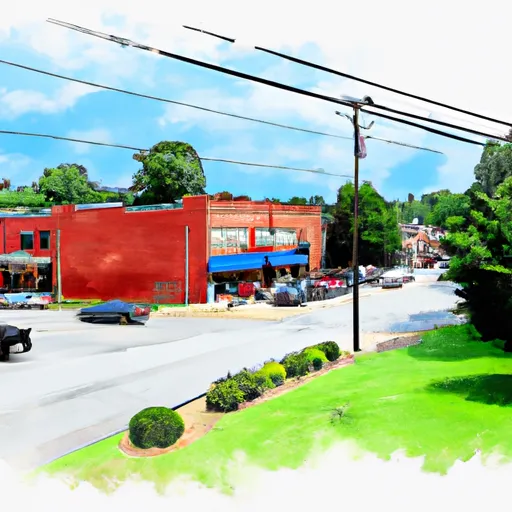-
 Snoflo Premium
Snoflo Premium
Get unlimited access to all our content
With no Ad interruptions! - Start Your Free Trial Login with existing account
Mc-Lemoresville
Eden Index
Climate
7.7
•
Recreation
1.1
•
Community
1.3
•
Safeguard
3.8/10

McLemoresville is a charming town located in Carroll County, Tennessee. Situated in the central part of the state, it experiences a humid subtropical climate, characterized by hot and humid summers and mild winters. Average temperatures range from the low 90s Fahrenheit in summer to the mid-30s in winter, creating a diverse climate throughout the year.
Hydrologically, the town is blessed with numerous creeks and streams that meander through its picturesque landscapes. These waterways play a significant role in providing water for irrigation and recreational activities in the area. McLemoresville is home to several lakes, including nearby Carroll Lake and the Kentucky Lake, which offer fantastic opportunities for boating, fishing, and swimming. Outdoor enthusiasts can also explore the surrounding forests and nature reserves, such as Natchez Trace State Park, which offers hiking and camping options.
Overall, McLemoresville offers a delightful climate and abundant hydrological features that provide ample opportunities for outdoor recreation. From enjoying the tranquil waters of the lakes to exploring the natural beauty of the area, residents and visitors alike can partake in a variety of outdoor activities in this charming Tennessee town.
What is the Eden Index?
The Snoflo Eden Index serves as a comprehensive rating system for regions, evaluating their desirability through a holistic assessment of climate health, outdoor recreation opportunities, and natural disaster risk, acknowledging the profound impact of these factors on livability and well-being.
Climate Health Indicator (CHI): 7.7
Mc-Lemoresville receives approximately
1363mm of rain per year,
with humidity levels near 84%
and air temperatures averaging around
15°C.
Mc-Lemoresville has a plant hardyness factor of
7, meaning
plants and agriculture in this region tend to thrive during the non-winter months.
By considering the ideal temperature range, reliable water supplies, clean air, and stable seasonal rain or snowpacks, the Climate Health Indicator (CHI) underscores the significance of a healthy climate as the foundation for quality living.
A healthy climate is paramount for ensuring a high quality of life and livability in a region, fostering both physical well-being and environmental harmony. This can be characterized by ideal temperatures, reliable access to water supplies, clean air, and consistent seasonal rain or snowpacks.
Weather Forecast
Streamflow Conditions
Hatchie-Obion
Area Rivers
Hatchie-Obion
Snowpack Depths
Hatchie-Obion
Reservoir Storage Capacity
Hatchie-Obion
Groundwater Levels
Recreational Opportunity Index (ROI): 1.1
The Recreational Opportunity Index (ROI) recognizes the value of outdoor recreational options, such as parks, hiking trails, camping sites, and fishing spots, while acknowledging that climate plays a pivotal role in ensuring the comfort and consistency of these experiences.
Access to outdoor recreational opportunities, encompassing activities such as parks, hiking, camping, and fishing, is crucial for overall well-being, and the climate plays a pivotal role in enabling and enhancing these experiences, ensuring that individuals can engage in nature-based activities comfortably and consistently.
Camping Areas
| Campground | Campsites | Reservations | Toilets | Showers | Elevation |
|---|---|---|---|---|---|
| Turkey Fork Rec. Area | 76 | 278 ft | |||
| Clarkco State Park | None | 273 ft | |||
| Gibson City Park | 4 | 731 ft | |||
| Shepard State Park | None | 16 ft | |||
| Lake Tom Bailey | 32 | 299 ft | |||
| Charley Brown City Park | None | 487 ft | |||
| Stephen A. Forbes State Park | 135 | 604 ft | |||
| Sam Dale Lake Conservation Area | None | 493 ft | |||
| Maynor Creek Waterpark | None | 362 ft | |||
| Archusa Creek Waterpark | 69 | 315 ft |
Nearby Fishing
Nearby Ski Areas
Catastrophe Safeguard Index (CSI):
The Catastrophe Safeguard Index (CSI) recognizes that natural disaster risk, encompassing floods, fires, hurricanes, and tornadoes, can drastically affect safety and the overall appeal of an area.
The level of natural disaster risk in a region significantly affects safety and the overall livability, with climate change amplifying these risks by potentially increasing the frequency and intensity of events like floods, fires, hurricanes, and tornadoes, thereby posing substantial challenges to community resilience and well-being.
Community Resilience Indicator (CRI): 1.3
The Community Resilience Indicator (CRI) recognizes that education, healthcare, and socioeconomics are crucial to the well-being of a region. The CRI acknowledges the profound impact of these elements on residents' overall quality of life. By evaluating educational resources, healthcare accessibility, and economic inclusivity, the index captures the essential aspects that contribute to a thriving community, fostering resident satisfaction, equity, and social cohesion.

